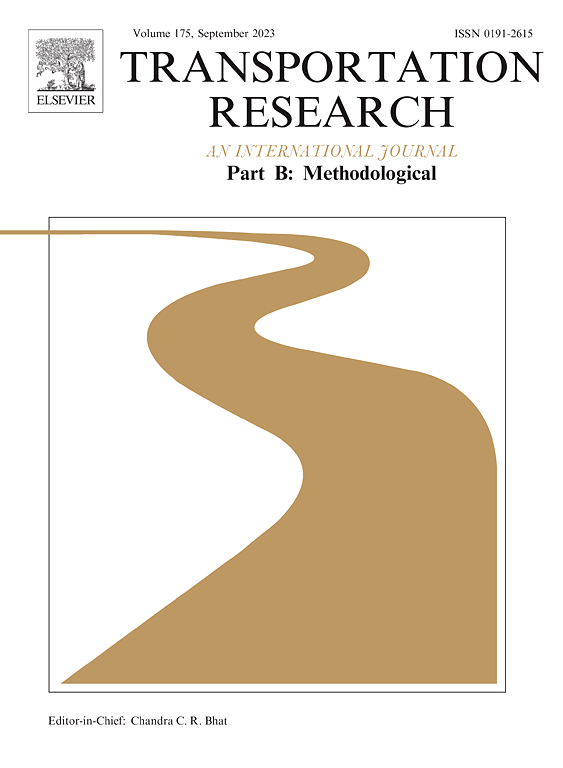通过模块化车辆缓解公交车拥挤问题
IF 5.8
1区 工程技术
Q1 ECONOMICS
引用次数: 0
摘要
无控制公交系统中普遍存在的公交车扎堆现象臭名昭著,这种现象会导致班次不正常,并通过增加乘客的预期等候时间来降低服务水平。模块化自动驾驶汽车(MAVs)由于能够在途中分流和合并,因此有可能帮助晚点和早点的公交车从班次偏差中恢复过来,同时提供连续的服务。在本文中,我们为 MAV 辅助公交系统提出了一种新颖的公交车拥挤缓解策略。我们首先考虑了软车辆容量约束,并建立了一个连续近似(CA)模型(模型 I)来捕捉与无人驾驶飞行器分流和合流操作交织在一起的系统动态,然后建立了一个无限视距随机优化模型来确定最优的分流和合流策略。为了捕捉乘客可能无法登上拥挤不堪的公交车这一现实情况,我们提出了第二个模型(模型 II),通过扩展模型 I 来适应硬性车辆容量约束。根据问题的特点,我们开发了一种定制的深度 Q 网络(DQN)算法,该算法具有多个中继缓冲区和适用于两种模型的惩罚性毁坏状态,以优化每辆 MAV 的策略。数值结果表明,通过 DQN 算法获得的策略是一种有效的防串策略,其性能优于 MAV 辅助系统的近视策略和传统总线系统的双向外观策略。此外,还进行了敏感性分析,以考察所提策略在不同运行情况下的有效性和优势。本文章由计算机程序翻译,如有差异,请以英文原文为准。
Alleviating bus bunching via modular vehicles
The notorious phenomenon of bus bunching prevailing in uncontrolled bus systems produces irregular headways and downgrades the level of service by increasing passengers’ expected waiting time. Modular autonomous vehicles (MAVs), due to their ability to split and merge en route, have the potential to help both late and early buses recover from schedule deviation while providing continuous service. In this paper, we propose a novel bus bunching alleviation strategy for MAV-aided transit systems. We first consider a soft vehicle capacity constraint and establish a continuum approximation (CA) model (Model I) to capture the system dynamics intertwined with the MAV splitting and merging operations, and then establish an infinite-horizon stochastic optimization model to determine the optimal splitting and merging strategy. To capture the reality that passengers may fail to board an overcrowded bus, we propose a second model (Model II) by extending Model I to accommodate a hard vehicle capacity constraint. Based on the characteristics of the problem, we develop a customized deep Q-network (DQN) algorithm with multiple relay buffers and a penalized ruin state applicable for both models to optimize the strategy for each MAV. Numerical results show that the strategy obtained via the DQN algorithm is an effective bunch-proof strategy and has a better performance than the myopic strategy for MAV-aided systems and the two-way-looking strategy for conventional bus systems. Sensitivity analyses are also conducted to examine the effectiveness and benefits of the proposed strategy across different operation scenarios.
求助全文
通过发布文献求助,成功后即可免费获取论文全文。
去求助
来源期刊
CiteScore
12.40
自引率
8.80%
发文量
143
审稿时长
14.1 weeks
期刊介绍:
Transportation Research: Part B publishes papers on all methodological aspects of the subject, particularly those that require mathematical analysis. The general theme of the journal is the development and solution of problems that are adequately motivated to deal with important aspects of the design and/or analysis of transportation systems. Areas covered include: traffic flow; design and analysis of transportation networks; control and scheduling; optimization; queuing theory; logistics; supply chains; development and application of statistical, econometric and mathematical models to address transportation problems; cost models; pricing and/or investment; traveler or shipper behavior; cost-benefit methodologies.

 求助内容:
求助内容: 应助结果提醒方式:
应助结果提醒方式:


